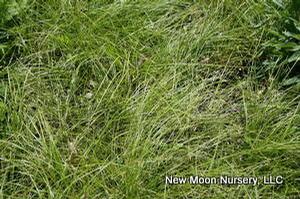Printed at http://www.newmoonnursery.com/index.cfm/
Carex albicans
White-tinged sedge
Native to North America
FIRST IMPRESSIONS: Carex albicans is a perennial sedge that grows in dense mounded tufts. The narrow thread-like foliage is bright green and fine textured. In late spring interesting scaly flower spikes emerge. The scales can be green, brown or tan but each scale will have a white margin. This is an upland sedge that thrives in a well drained shade garden or dry woodland.
HABITAT & HARDINESS: Carex albicans is native to North America from Quebec and Ontario south to Florida and Texas.
Plants are indigenous to deciduous woods, clearings. wooded slopes, shaded ledges and occasionally to sandy bottomland forests This sedge often occur in dry high spots in mature Maple, Oak and Beech forests. Hardy from USDA Zones 4-8.
PLANT DESCRIPTION: Carex albicans is a clump forming perennial sedge with narrow grass-like arching leaves. Plants spread slowly from underground rhizomes and gradually form colonies.
Leaves are flat, bright green and less than 1/8” wide.
Flowers bloom in late spring on stems that are held above the foliage. Each flower stalk consists of a scaly terminal staminate (male) flower spike with a scaly pistilate (female) flower spike beneath. Staminate scales are green to tan with tinges of purple and pistillate scales are dark brown. Both have white margins. The fruit is a triangular one seeded achene enclosed in a sac-like perigynium
Plants are 15-20” tall with an equal spread.
CULTURAL & MAINTENANCE NEEDS: This sedge tolerates shade and drought and is an excellent selection for difficult dry shaded sites.
Plants self-seed but since they are not aggressive seeders this is usually not an issue.
Like most sedges, this one is pest resistant and unpalatable to deer and other herbivores.
LANDSCAPE USES: Carex albicans is a useful Groundcover or Lawn Substitute for a Shade Garden. This sedge is good in a Grouping or Mass Planting. It provides Erosion Control and is appropriate for Deer Resistant Plantings, Water Wise Landscapes and Low Maintenance Plantings. This sedge is be a great native substitute for the popular Asian groundcovers Liriope muscari or Ophiopogon japonicus.
COMPANION & UNDERSTUDY PLANTS: Try pairing plants with Antennaria neglecta, Chrysogonum virginianum, Heuchera americana 'Dales Strain', Iris cristata 'Tennessee White', Phlox divaricata, Tiarella cordifolia or Polystichum acrostichoides.
Carex appalachica.is similar in appearance and cultural needs and can be substituted if needed in cooler northern sites. In hotter southern locations, Carex albicans would be a better choice.
TRIVIA: Over 1500 species of Carex spp. grow in a variety of often moist to wet habitats throughout the world. Identification of individual species can be very difficult. The plant must be in bloom and generally a magnifying glass is needed.
The word Carex comes from Latin and means "cutter". This refers to the sharp leaf and stem edges found on most species. Or as they say “Rushes are round but sedges have edges.”
To the uninitiated, Carex spp. seem almost undistinguishable from many grasses. Both have fibrous roots, narrow linear leaves with parallel veins and usually have underground rhizomes. Carex spp. are perennials with solid triangular stems. Grasses are annual or perennial with round stems that are often hollow. Grass stems have swollen nodes or joints and Carex spp. stems do not.
Height:
15-20 InchesSpread:
15-20 inSpacing:
12-18 inUSDA Hardiness Zone:
4-8Bloom Color:
GreenCarex albicans Characteristics
Attracts Wildlife
- Pollinators
- Songbirds
Attributes
- Ground Cover
Exposure
- Partial Shade to Full Shade
Flowering Months
- May
Foliage Color
- Green
Grass Season
- Cool Season Grass
Groundcover Foot-Traffic Tolerances
- Light
Lawn Replacement or Groundcover
- Groundcover
- Lawn Replacement
Soil Moisture Preference
- Moist to Dry
Interesting Notes:
For more information on this plant, visit the USDA PLANTS Database: http://plants.usda.gov/java/profile?symbol=CAAL25

